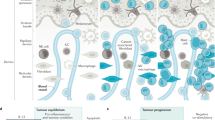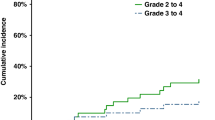Summary:
Treatment of cutaneous T-cell and B-cell lymphomas is difficult and relapses are frequent. To evaluate the efficiency of high-dose therapy (HDT) and autologous stem cell transplantation (ASCT) on relapsing cutaneous lymphomas, we conducted a retrospective study of 14 patients. We investigated the clinical and histological parameters of the lymphoma, previous treatments to ASCT, short-term complications of ASCT, and occurrence of a relapse. There were 11 males and three females, with a median age of 42 years. Most often, the skin disease was disseminated without extracutaneous involvement. Four patients had a B-cell lymphoma and 10 a T-cell lymphoma. CD30 was negative in 8/10 T-cell lymphomas. Before ASCT, 13 patients had chemosensitive disease; one had refractory disease. The conditioning regimen included TBI in nine cases. No toxic death occurred. Relapse of the lymphoma occurred in eight cases (T-cell lymphoma in seven cases), within 4 months after ASCT in six cases. Relapses were treated with local treatment, interferon or classical chemotherapy. At the end of the study, 11 patients were alive and three patients had died. HDT and ASCT do not benefit patients with T-cell lymphomas. For patients with disseminated relapsing cutaneous B-cell lymphomas, this procedure should be considered.
This is a preview of subscription content, access via your institution
Access options
Subscribe to this journal
Receive 12 print issues and online access
$259.00 per year
only $21.58 per issue
Buy this article
- Purchase on Springer Link
- Instant access to full article PDF
Prices may be subject to local taxes which are calculated during checkout
Similar content being viewed by others
References
Sander CA, Kind P, Kaudewitz P et al. The REAL classification of lymphoid neoplasms: a new perspective for the classification of cutaneous lymphoma. J Cutan Pathol 1997; 24: 329–341.
Mirza I, Macpherson N, Paproski S et al. Primary cutaneous follicular lymphoma: an assessment of clinical, histopathologic, immunophenotypic and molecular features. J Clin Oncol 2002; 20: 647–655.
Willemze R, Kerl H, Sterry W et al. EORTC classification for primary cutaneous lymphomas: a proposal from the cutaneous lymphoma study group of the European organization for research and treatment of cancer. Blood 1997; 1: 354–371.
Knobler RM, Edelson RL . Cutaneous T cell lymphoma. Med Clin North Am 1986; 70: 109–138.
Kaye FJ, Bunn PA, Steinberg SM et al. A randomised trial comparing combination electron-beam radiation and chemotherapy with topical therapy in the initial treatment of mycosis fungoides. New Engl J Med 1989; 321: 1784–1790.
Burke JS, Hoppe RT, Cibull ML, Dorfman RF . Cutaneous malignant lymphoma, a pathologic study of 50 cases with clinical analysis of 37. Cancer 1981; 47: 300–310.
Brice P, Cazals D, Mounier N et al. Primary cutaneous large-cell lymphoma: analysis of 49 patients included in the LNH87 prospective trial of polychemotherapy for high-grade lymphomas. Leukemia 1998; 12: 213–219.
Joly P, Charlotte F, Leibowitch M et al. Cutaneous lymphomas other than mycosis fungoides: follow up study of 52 patients. J Clin Oncol 1991; 9: 1994–2001.
Bosly A, Coiffier B, Gisselbrecht C et al. Bone marrow transplantation prolongs survival after relapse in aggressive lymphoma patients treated with the LNH84 regimen. J Clin Oncol 1992; 10: 1612–1623.
Philip T, Guglielmi C, Hagenbeek A et al. Autologous bone marrow transplantation as compared with salvage chemotherapy in relapses of chemotherapy sensitive non-Hodgkin's lymphoma. N Engl J Med 1995; 333: 1540–1545.
Horning SJ . Natural history of and therapy for the indolent non-Hodgkin's lymphoma. Semin Oncol 1993; 20 (Suppl. 5): 75–88.
Freedman AS, Ritz J, Neuberg D et al. Autologous bone marrow transplantation in 69 patients with a history of low-grade B-cell non Hodgkin's lymphoma. Blood 1991; 77: 2524–2529.
Bastion Y, Brice P, Haioun C et al. Intensive therapy with peripheral blood progenitor cell transplantation in 60 patients with poor-prognosis follicular lymphoma. Blood 1995; 86: 3257–3262.
Cheson BD, Horning SJ, Coiffier B et al. Report of an international workshop to standardize response criteria for non-Hodgkin's lymphomas. NCI sponsored international working group. J Clin Oncol 1999; 17: 1244.
Brice P, Marolleau JP, Pautier P et al. Hematologic recovery and survival of lymphoma patients after autologous stem-cell transplantation: comparison of bone marrow and peripheral blood progenitor cells. Leuk Lymphoma 1996; 22: 449–456.
Gribben JG, Linch DC, Singer CR et al. Successful treatment of refractory Hodgkin's disease by high-dose combination chemotherapy and autologous bone marrow transplantation. Blood 1989; 73: 340–344.
Marolleau JP, Baccard M, Flageul B et al. High dose recombinant interleukin-2 in advanced cutaneous T-cell lymphoma. Arch Dermatol 1995; 131: 574–579.
Gisselbrecht C, Gaulard P, Lepage E et al. Prognostic significance of T-cell phenotype in aggressive non-Hodgkin's lymphomas. Blood 1998; 92: 76–82.
Shipp MA . Prognostic factors in aggressive non-Hodgkin's lymphoma: who has ‘high-risk’ disease? Blood 1994; 83: 1165–1173.
Bigler RD, Crilley P, Micaily B et al. Autologous bone marrow transplantation for advanced stage mycosis fungoides. Bone Marrow Transplant 1991; 7: 133–137.
Moreau P, LeTortorec S, Mahé MA et al. Autologous bone marrow transplantation using TBI and CBV for disseminated high/intermediate grade cutaneous non-epidermotropic non-Hodgkin's lymphoma. Bone Marrow Transplant 1994; 14: 775–778.
Fanin R, Silvestri F, Geromin A et al. Primary systemic CD30 (Ki-1)-positive anaplastic large cell lymphoma of the adult: sequential intensive treatment with the F-MACHOP regimen (+/−radiotherapy) and autologous bone marrow transplantation. Blood 1996; 4: 1243–1248.
Olavarria E, Child F, Woolford A et al. T-cell depletion and autologous stem cell transplantation in the management of tumour stage mycosis fungoides with peripheral blood involvement. Br J Haematol 2001; 114: 624–631.
Sterling JC, Marcus R, Burrows NP, Roberts SOB . Erythrodermic mycosis fungoides treated with total body irradiation and autologous bone marrow transplantation. Clin Exp Dermatol 1995; 20: 73–75.
Ferra C, Servitje O, Petriz L et al. Autologous haematopoietic progenitor transplantation in advanced mycosis fungoides. Br J Dermatol 1999; 140: 1188–1189.
Author information
Authors and Affiliations
Corresponding author
Rights and permissions
About this article
Cite this article
Ingen-Housz-Oro, S., Bachelez, H., Verola, O. et al. High-dose therapy and autologous stem cell transplantation in relapsing cutaneous lymphoma. Bone Marrow Transplant 33, 629–634 (2004). https://doi.org/10.1038/sj.bmt.1704411
Received:
Accepted:
Published:
Issue Date:
DOI: https://doi.org/10.1038/sj.bmt.1704411
Keywords
This article is cited by
-
Discussion on the indication of allogeneic stem cell transplantation for advanced cutaneous T cell lymphomas
International Journal of Hematology (2019)
-
Allogeneic hematopoietic stem cell transplantation in Primary Cutaneous T Cell Lymphoma
Annals of Hematology (2018)
-
CD30+ Neoplasms of the Skin
Current Hematologic Malignancy Reports (2011)
-
Haematopoietic stem cell transplantation for patients with primary cutaneous T-cell lymphoma
Bone Marrow Transplantation (2008)
-
Graft-versus-lymphoma effect in refractory cutaneous T-cell lymphoma after reduced-intensity HLA-matched sibling allogeneic stem cell transplantation
Bone Marrow Transplantation (2004)



